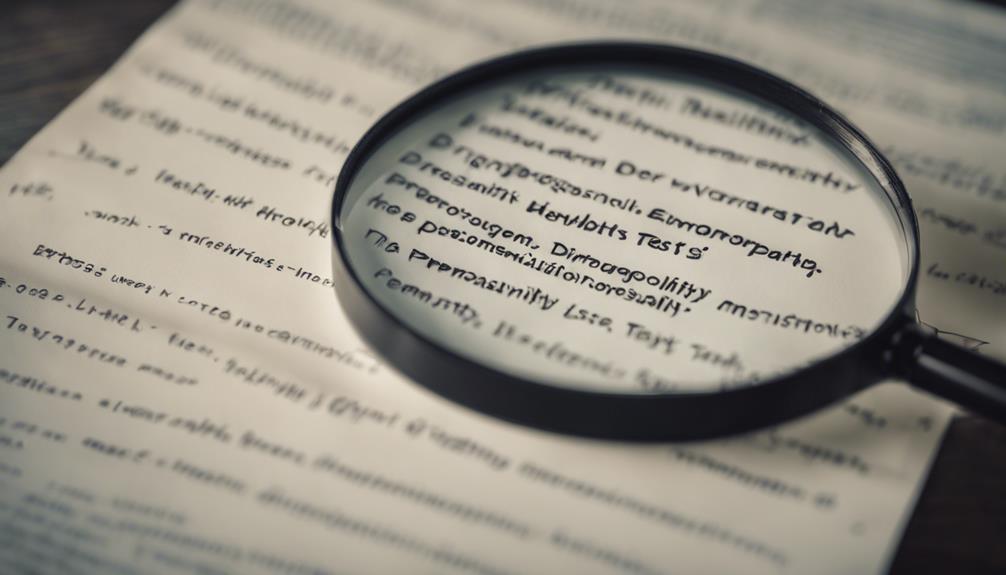Decoding the Narcissistic Personality Disorder Test provides invaluable insight into narcissistic traits, aiding in early identification and fostering self-reflection essential for mental well-being. The test serves as a valuable tool to understand and address potential issues related to narcissistic behavior. Seeking professional guidance for interpreting the test results can offer a starting point for self-awareness and tailored strategies. Therapy options like CBT and DBT, alongside support groups and online resources, can complement efforts towards personal growth and healing. Exploring these avenues can lead to a deeper understanding of oneself and improved emotional well-being.
Key Takeaways
- NPD test offers insights into narcissistic traits for self-reflection.
- Results can prompt early identification of NPD symptoms.
- Consult a mental health professional for insightful interpretation.
- Use test as a starting point to address narcissistic traits.
- Seeking therapy, support groups, and tailored strategies are vital for managing NPD.
Understanding Narcissistic Personality Disorder
Understanding Narcissistic Personality Disorder involves recognizing the key traits and behaviors associated with this complex psychological condition. Narcissistic Personality Disorder (NPD) falls under the Cluster B Personality disorders in the mental health spectrum. It's characterized by an individual's inflated sense of importance, a constant need for admiration, and a lack of empathy towards others.
Causes of Narcissistic Personality Disorder can be multi-faceted, involving genetic predispositions, environmental factors, and early life experiences. Seeking professional help is vital for the effective treatment of NPD. Mental health professionals employ various therapeutic approaches to address the underlying issues contributing to this disorder. Treatment may involve psychotherapy, such as cognitive-behavioral therapy, aimed at improving self-awareness and empathy. Additionally, group therapy or support groups can be beneficial in fostering healthier relationship dynamics.
Understanding the complexities of NPD is essential for both individuals living with the disorder and those interacting with them in various social contexts.
Symptoms and Behaviors to Watch For

Observing individuals for signs of grandiosity, a constant need for admiration, lack of empathy, entitlement, and manipulative behaviors can help in identifying potential symptoms of Narcissistic Personality Disorder (NPD). People with NPD often exhibit behaviors that revolve around self-importance and a desire for special treatment. Here are some key symptoms and behaviors to watch for when considering NPD:
| Symptoms | Behaviors |
|---|---|
| Grandiosity | Constant need for admiration |
| Lack of empathy | Entitlement and expectations of special treatment |
| Manipulative tendencies | Disregard for others' feelings |
Individuals with NPD may display an inflated sense of self-worth, seeking validation and admiration from others while showing little empathy towards those around them. They often believe they deserve preferential treatment and can manipulate situations to fulfill their desires. Recognizing these traits can be essential in identifying and understanding NPD for appropriate intervention and support.
Importance of Taking the NPD Test

Exploring the significance of undergoing the NPD test can offer valuable insights into potential narcissistic traits. This test serves as a tool to gauge behaviors and symptoms associated with Narcissistic Personality Disorder (NPD).
By taking the test, individuals can gain a better understanding of their sense of self and whether they exhibit traits commonly linked to NPD, such as a desire for special treatment and a fragile self-esteem.
Recognizing these characteristics through the test results can be an essential first step in addressing any underlying mental health conditions. It can prompt self-reflection and potentially lead to seeking appropriate support or treatment if needed.
Additionally, the NPD test can act as a guide for further evaluation by mental health professionals, aiding in the early identification and management of any potential issues related to narcissistic traits.
Taking the NPD test can be a proactive measure in promoting overall mental well-being and self-awareness.
Interpreting NPD Test Results

Once the NPD test results are obtained, careful consideration and analysis by a qualified mental health professional are essential for accurate interpretation. Understanding the significance of each trait in the context of narcissistic personality disorder is vital for an insightful interpretation.
Here's how to interpret NPD test results effectively:
- Consultation: Seek guidance from a mental health professional to interpret the results accurately and gain a deeper understanding of any narcissistic tendencies indicated.
- Self-Awareness: Use the test results as a tool for self-reflection and awareness of potential narcissistic behaviors in your personality, helping you identify areas for personal growth.
- Interpretation: Consider the test results as a starting point for discussions on how to address any concerning traits and work towards developing healthier behaviors and relationships.
Seeking Support and Solutions

To effectively address narcissistic personality disorder, seeking support and exploring solutions through therapy and counseling is paramount. Therapy options such as cognitive-behavioral therapy (CBT) and dialectical behavior therapy (DBT) have shown effectiveness in treating NPD symptoms by addressing thought patterns and emotional regulation. Support groups offer a sense of community and understanding for individuals maneuvering through the complexities of NPD. Professional guidance is essential for creating personalized strategies to manage symptoms and foster personal growth. Online resources can complement traditional therapy by providing additional information and guidance for those seeking support for NPD. Below is a table highlighting key avenues for seeking support and solutions for narcissistic personality disorder:
| Support and Solutions | Description |
|---|---|
| Therapy (CBT, DBT) | Addressing thought patterns and emotions to manage NPD symptoms effectively. |
| Support Groups | Providing community and understanding for individuals dealing with NPD. |
| Professional Guidance | Tailoring personalized strategies to manage NPD symptoms and facilitate personal development. |
| Online Resources | Offering additional information and guidance to complement traditional therapy approaches. |
Frequently Asked Questions
What Words Can Destroy a Narcissist?
It's crucial to be mindful of language when dealing with narcissistic personalities to prevent unnecessary conflict. Certain words that can devastate a narcissist include those challenging their superiority or questioning their achievements.
Criticism of their self-image or abilities often triggers defensive or aggressive reactions. Additionally, words threatening their control, power, or admiration may spark narcissistic rage. Sensitivities and insecurities play a role in how these words impact each individual.
How Do You Get a Narcissist to Realize They Are a Narcissist?
To help a narcissist realize they're a narcissist, we should approach gently, provide examples of their behaviors, suggest seeking professional evaluation, offer support, and emphasize self-awareness.
By using non-confrontational language and specific instances, we can guide them towards self-reflection and growth.
Seeking help from a mental health professional is essential for an accurate diagnosis and effective treatment. Supporting them through therapy or support groups can aid in their journey towards understanding and acceptance.
How Do You Make a Narcissist Realize They Are Wrong?
When dealing with a narcissist who needs to realize they're wrong, employing strategic tactics is key.
Engage in calm discussions, steer clear of triggering defenses, and offer constructive feedback focusing on behaviors.
Encourage self-reflection by posing open-ended questions.
If communication hits a wall, professional mediation can help navigate challenges.
How Do You Disarm a Narcissist?
When disarming a narcissist, setting clear boundaries and avoiding power struggles are key. Refrain from giving them excessive attention or admiration to reduce their manipulative behavior. Assertiveness and direct communication are effective tools to prevent their control.
Stay calm and composed to prevent conflicts from escalating. Seeking guidance from a therapist can provide helpful strategies for managing interactions with a narcissist.
Conclusion
In summary, understanding and recognizing the signs of Narcissistic Personality Disorder is essential for seeking help and finding solutions.
By taking the NPD test and interpreting the results, individuals can take the first step towards addressing any narcissistic behaviors.
Remember, seeking support from professionals and loved ones is vital to navigating this complex personality disorder.
Don't hesitate to reach out for help and start on the path towards healing and growth.
Chris brings a wealth of knowledge and personal experience to the role of Expert Author. With a focus on narcissistic personality disorder and recovery processes, Chris’s articles offer a mix of expert analysis, personal anecdotes, and actionable advice. Their work enriches our platform with depth, authenticity, and a perspective that resonates with those who have experienced narcissism firsthand.











